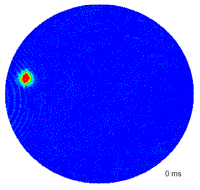After being the first to translate Einstein's Relativity theories from German to English, Saha and Bose continued to blossom in their career. They, along with P.C. Mahalanobis, who wrote the introduction, went on to have illustrious careers.
Meghnad Saha (1893-1956; Fellow Royal Society 1927; also
here) went on to become world famous for his
Saha Equation on the thermal ionization of elements, a basic tool to determine the spectra of stars and to determine the ionization elements of the stars. Among his many other notable achievements was the development of numerous scientific institutions in India, including the
Saha Institute of Nuclear Physics, the journal
Science and Culture (published by the Indian Science Association and started by Saha in 1934), and being in charge of river management and development for the Government of India. Saha and Bose were classmates since their childhood, and had a sometimes contentious, but always close, lifelong friendship.
Bose went on to discover
Bose Statistics (1924), Fellow Royal Society 1958, and other things that we will cover in this Blog.
Prasanta Chandra Mahalanobis (1893-1972, Fellow Royal Society 1945) is considered the father of applied statistics in India, and was one of India's leading planners. He was, among other things, the founder of the
Indian Statistical Institute, as well as personal secretary to the
Poet Rabindranath Tagore (Asia's first Nobel Laureate winning for Literature in 1913). Indeed, there is a widely repeated anecdote that when Einstein met Tagore (possibly in 1930) and asked "How is that bright young man Bose?" Tagore was perplexed since the Bose that he did know (the famous physicist
Jagadish Chandra Bose) was far from being a young man at that time. He is said to have asked his secretary, PC Mahalanobis, about this Bose, and Mahalanobis was said to have proclaimed, "Oh, he means Satyen Bose!"
Tagore was intrigued, and said that he would like to meet this Satyen. Mahalanobis facilitated an introduction that lead to an ongoing relationship till Tagore's death in 1941. Bose's mother was said to have said with pride that "
it was Albert Einstein who told Gurudev about my son, and Gurudev himself asked to meet him..."The relationship between Bose and Tagore blossomed around a mutually held passion of teaching science (and literature) in the "mother-tongue" of Bengali. Indeed, one of Tagore's last works was
Viswa-Parichay [
বিশ্ব-পরিচয়] (
Our Universe 1937, translated by Indra Dutta 1958), a science primer written in Bengali, which he dedicated to Bose. Many years later, Bose went on to be appointed Vice-Chancellor of Tagore's university,
Viswabharati (Santiniketan) in 1957.
But that's another story...
 Historical Introduction
Historical Introduction



